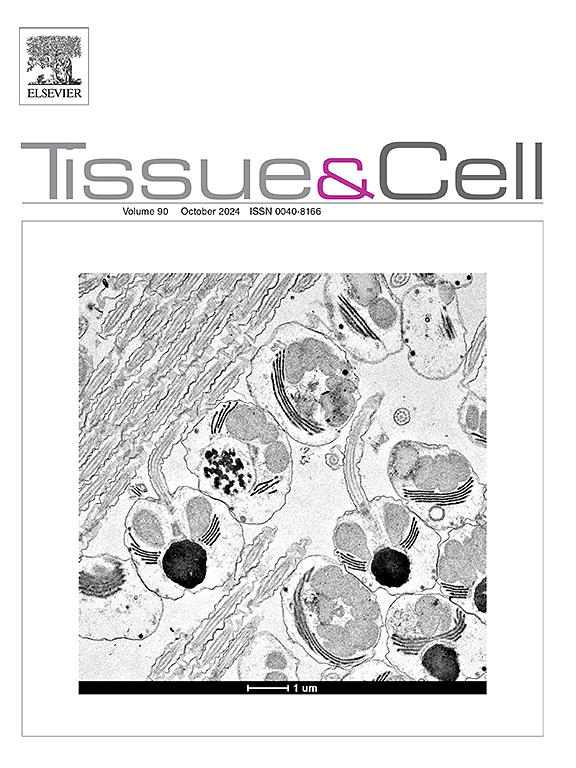OTUD5 enhances activation of multiple cell death pathways and hyperoxia-induced lung injury by stabilizing TRAF4 and activating the p38/JNK pathway
IF 2.7
4区 生物学
Q1 ANATOMY & MORPHOLOGY
引用次数: 0
Abstract
Objective
This study aims to elucidate the role of OTUD5 in hyperoxia-induced lung injury and to explore its potential as a therapeutic target for mitigating oxidative stress-related lung damage.
Methods
AAV9-OTUD5 siRNA was administered via intratracheal injection in a mouse model to silence OTUD5 before exposure to 60 % O2 for 24 h. Lung tissues were analyzed using histological techniques (HE, Masson’s, PAS staining) and quantified for collagen deposition and airway epithelial changes. Additionally, qPCR and WB analysisWB analysis assessed OTUD5 and TRAF4 expression levels. Co-immunoprecipitation and dual-immunofluorescence assays evaluated the interaction between OTUD5 and TRAF4. Apoptosis was measured via TUNEL staining and Cleaved-Caspase-3 expression analysis, while ROS levels were assessed using MitoSOX.
Results
Silencing OTUD5 significantly reduced lung injury, evidenced by improved histological architecture and decreased collagen deposition. OTUD5 knockdown attenuated apoptosis markers and ROS production in BEAS-2B cells exposed to hyperoxia. Co-IP assays confirmed that OTUD5 stabilizes TRAF4, linking it to the activation of the p38/JNK signaling pathway. Furthermore, treatment with metformin and berberine chloride diminished the protective effects of OTUD5 knockdown in vivo.
Conclusion
OTUD5 plays a critical role in hyperoxia-induced lung injury through the regulation of TRAF4 stability and apoptotic pathways. Targeting OTUD5 may provide a novel therapeutic strategy to mitigate lung damage in conditions characterized by oxidative stress.
OTUD5通过稳定TRAF4和激活p38/JNK通路来增强多种细胞死亡途径和高氧诱导的肺损伤的激活
目的本研究旨在阐明OTUD5在高氧诱导肺损伤中的作用,并探讨其作为减轻氧化应激相关肺损伤的治疗靶点的潜力。方法在小鼠模型中气管内注射saav9 -OTUD5 siRNA,使OTUD5沉默,然后暴露于60% % O2中24 h。采用组织学技术(HE、Masson’s、PAS染色)分析肺组织,并定量检测胶原沉积和气道上皮变化。此外,qPCR和WB分析,WB分析评估OTUD5和TRAF4的表达水平。免疫共沉淀法和双免疫荧光法评估OTUD5和TRAF4之间的相互作用。通过TUNEL染色和Cleaved-Caspase-3表达分析检测细胞凋亡,使用MitoSOX检测ROS水平。结果沉默OTUD5可显著减轻肺损伤,组织学结构改善,胶原沉积减少。在暴露于高氧环境下的BEAS-2B细胞中,OTUD5敲除可减弱凋亡标志物和ROS的产生。Co-IP实验证实OTUD5可以稳定TRAF4,将其与p38/JNK信号通路的激活联系起来。此外,二甲双胍和氯化小檗碱治疗降低了OTUD5在体内的保护作用。结论otud5通过调节TRAF4的稳定性和凋亡通路,在高氧诱导的肺损伤中起关键作用。靶向OTUD5可能提供一种新的治疗策略来减轻以氧化应激为特征的肺损伤。
本文章由计算机程序翻译,如有差异,请以英文原文为准。
求助全文
约1分钟内获得全文
求助全文
来源期刊

Tissue & cell
医学-解剖学与形态学
CiteScore
3.90
自引率
0.00%
发文量
234
期刊介绍:
Tissue and Cell is devoted to original research on the organization of cells, subcellular and extracellular components at all levels, including the grouping and interrelations of cells in tissues and organs. The journal encourages submission of ultrastructural studies that provide novel insights into structure, function and physiology of cells and tissues, in health and disease. Bioengineering and stem cells studies focused on the description of morphological and/or histological data are also welcomed.
Studies investigating the effect of compounds and/or substances on structure of cells and tissues are generally outside the scope of this journal. For consideration, studies should contain a clear rationale on the use of (a) given substance(s), have a compelling morphological and structural focus and present novel incremental findings from previous literature.
 求助内容:
求助内容: 应助结果提醒方式:
应助结果提醒方式:


